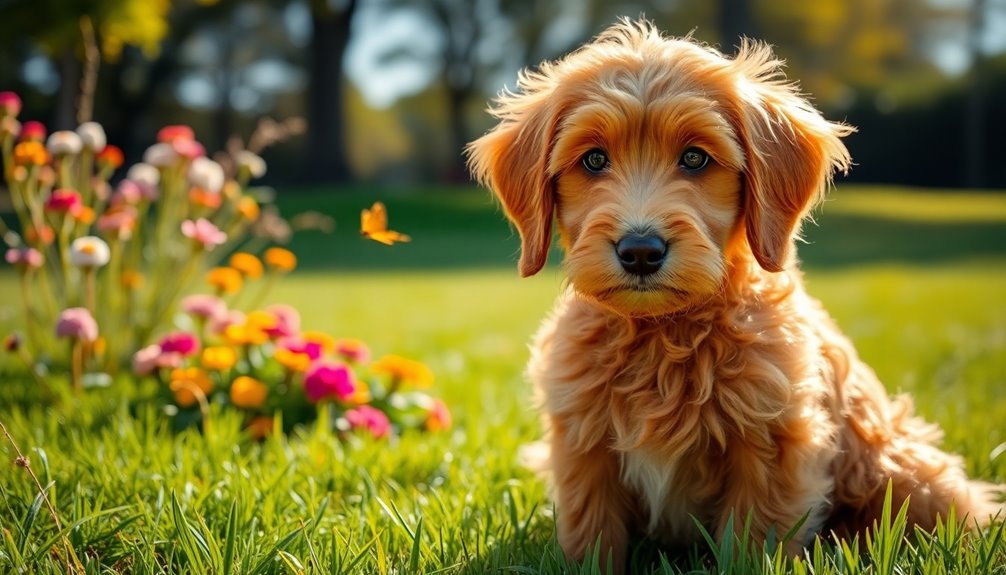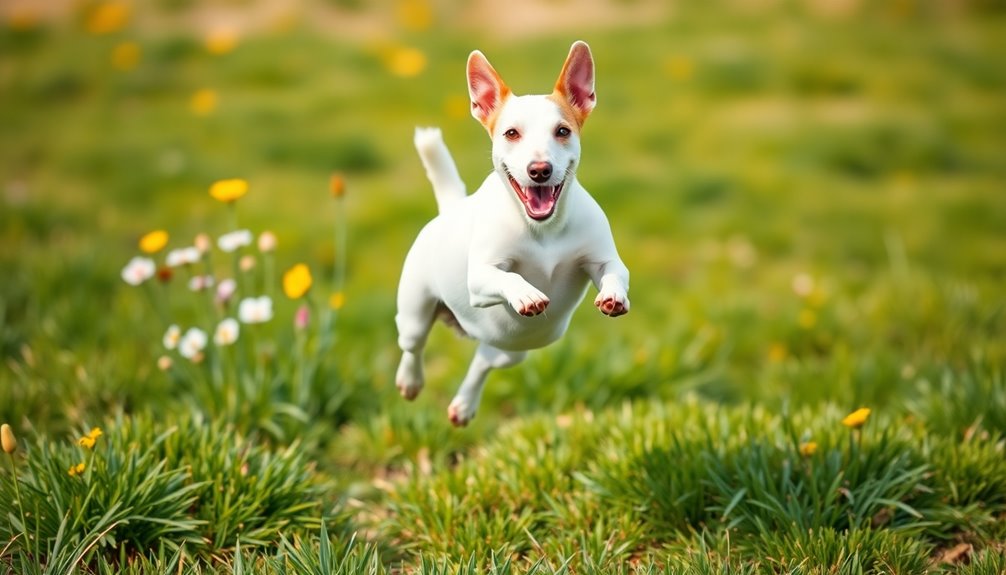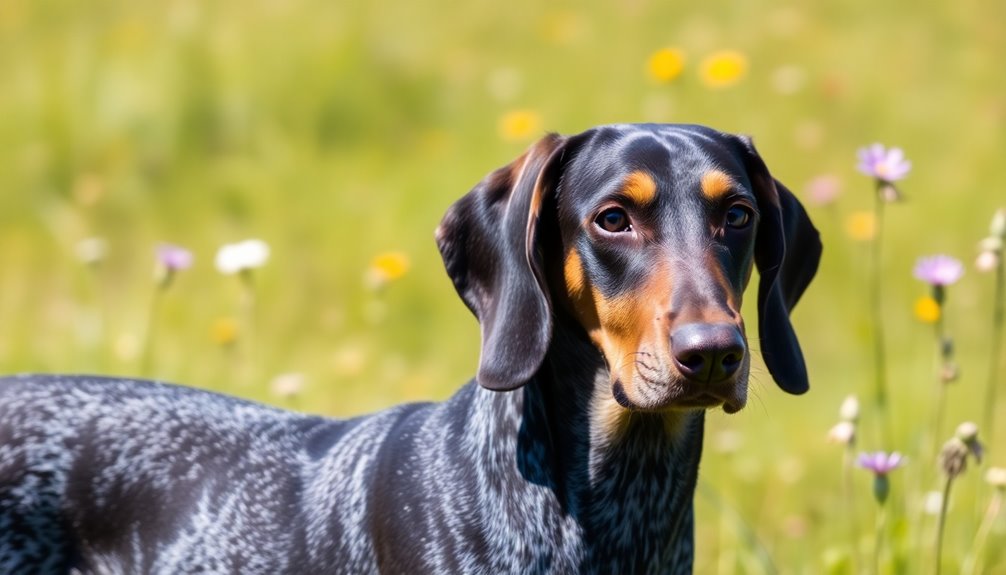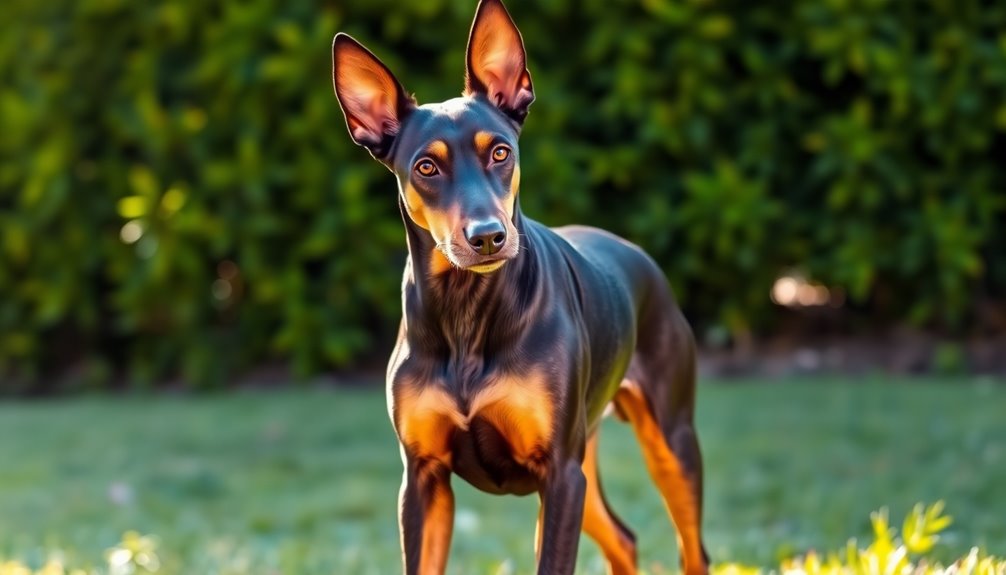The Komondor, known as the "majestic mop dog," boasts a unique corded coat that resembles dreadlocks and offers natural protection against the elements. Originating in Hungary, these large, powerful dogs were traditionally used to guard livestock. Their protective, loyal nature makes them great companions for families with dog-savvy children. However, they require early socialization and consistent training due to their independent spirit. Regular grooming is essential to maintain their distinctive coat and minimize matting, which can be quite an undertaking. If you're curious about their care and other fascinating traits, there's much more to discover!
Key Takeaways
- The Komondor is a large, powerful breed originally used as livestock guardians in Hungary, known for its unique corded coat resembling dreadlocks.
- Their distinctive coat provides insulation and protection against harsh weather and predators, requiring regular grooming to maintain its cord structure.
- With a protective and loyal temperament, Komondors bond closely with their families and are excellent watchdogs, but early socialization is essential.
- They thrive in active households and require regular exercise, with a balanced diet crucial for their health and longevity.
- Common health concerns include hip dysplasia, bloat, and skin irritations, necessitating regular veterinary care and monitoring.
Introduction
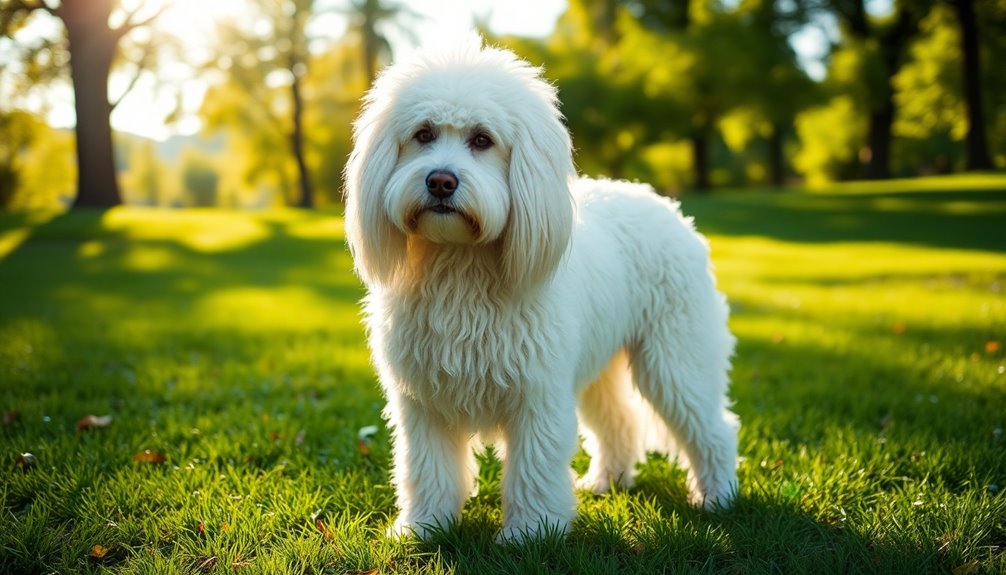
Introducing the Komondor, you'll quickly realize that this majestic mop dog isn't just a unique breed but a loyal guardian and companion. Standing proudly at heights between 25.5 to 31.5 inches and weighing anywhere from 80 to 132 pounds, the Komondor boasts a muscular build, deep chest, and powerful legs. Its striking, corded white coat, resembling dreadlocks, not only captures attention but also provides insulation and protection against harsh weather and predators.
However, don't underestimate the grooming needs of this breed. The magnificent cords take about two years to form fully and require regular maintenance to prevent matting. Once matured, the coat sheds minimally, making it easier to manage compared to its puppy phase. The Komondor's distinctive corded coat serves as a natural armor, allowing it to excel in its role as a guardian of livestock.
The Komondor's brave and vigilant nature makes it an excellent protector, often serving as a livestock guardian. While they're affectionate with their owners, they can be wary of strangers, especially children and other dogs. With a high energy level, they thrive on regular training and exercise, ensuring both physical health and a balanced lifestyle. This breed is truly a remarkable companion for those willing to invest the time and care they deserve.
History and Origin
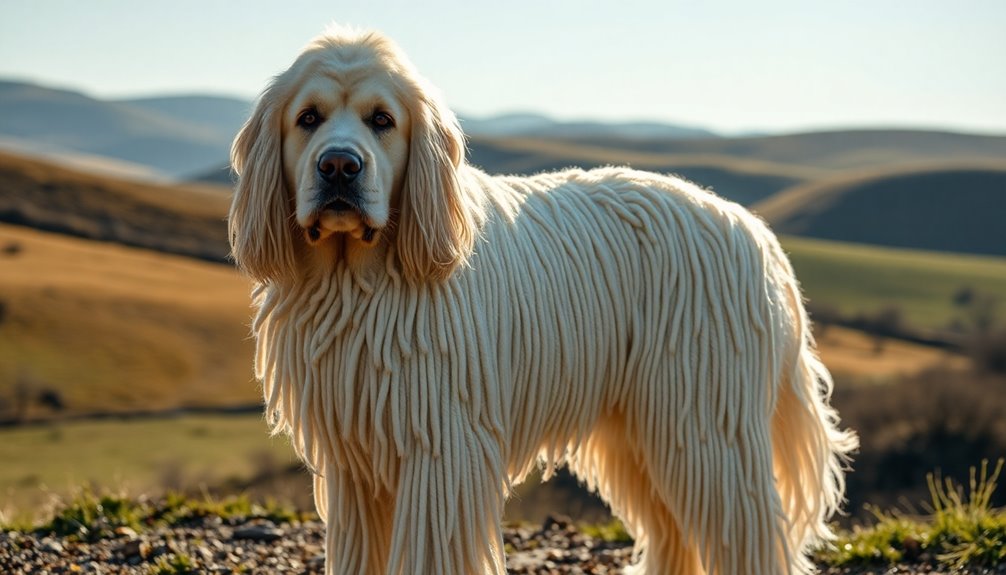
The Komondor originated in Hungary, brought by the nomadic Cumans in the 12th and 13th centuries.
This breed was primarily used as a livestock guardian, protecting sheep and cattle from predators.
Its unique corded coat not only provided insulation but also helped it blend in with the flocks it was meant to defend. The breed's origins can be traced back to herding practices in Hungary, showcasing its long-standing relationship with livestock management.
Where and when the breed originated
Originating from Asia, east of the Yellow River, the Komondor breed has a rich history that dates back to ancient times. Its ancestors, believed to descend from Tibetan dogs, traveled with the Cuman and Magyar tribes to Hungary around 896 AD. These dogs, known for their herding and guarding abilities, show lineage to ancient breeds like the Russian Ovcharka.
The Cumans, a Turkic-speaking nomadic people, migrated westward due to the Mongol expansion in the late 10th century. By the 12th century, they reached Hungary and were granted asylum in 1239 under Köten Khan. Along with their families, they brought their dogs, which would eventually evolve into the Komondor. Archaeological evidence, including Cuman gravesites, confirms the presence of these dogs in the region. The breed was primarily developed as livestock guardians, showcasing their importance in protecting herds from predators.
The first written mention of the breed appeared in a Hungarian codex from 1544, highlighting its significance in history. The term "Komondor" translates to "dog of the Cumans," reflecting the breed's deep connection to its origins.
This unique ancestry sets the foundation for the Komondor's identity as a cherished guardian and companion.
Livestock Guardian in Hungary
As the Komondor settled into its role in Hungary, it became a vital part of agricultural life. These remarkable dogs were specifically bred to guard livestock, protecting sheep, goats, and cattle from predators like wolves, coyotes, and bears.
With their thick, corded coats acting as natural armor, they could withstand harsh weather while blending into flocks, providing excellent camouflage. Their unique dense, white corded coat also protects against elements and predators, making them ideal guardians.
You'd admire their calm demeanor during normal times, but when trouble arose, their fearless nature shone through. Known for their independent thinking, Komondors made quick decisions to defend their charges, displaying both loyalty and intelligence.
They're affectionate with families and gentle with children, yet they remain wary of strangers, necessitating early socialization to help them differentiate between friends and foes.
Despite their large size—males often exceeding 100 pounds—they're surprisingly agile and fast.
The breed faced near extinction during World War II, but Hungary's dedication helped revive the population, with about 1,000 registered between the war and 1960.
Recognized as a national treasure, the Komondor remains a symbol of resilience and protection in Hungary's agricultural landscape.
Physical Characteristics
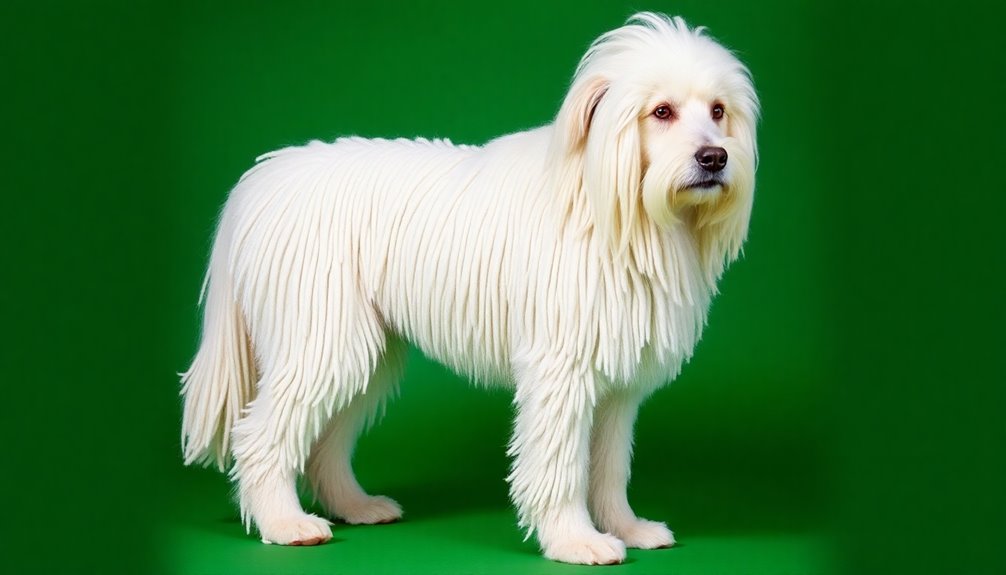
When you consider the Komondor, its impressive size and weight immediately stand out, with males reaching over 100 pounds and females not far behind. Their unique, corded coat, resembling a mop, isn't just for looks; it provides vital protection against the elements. This breed's robust build and distinctive rope-like texture make them truly one of a kind in the canine world. Additionally, their vigilant nature allows them to effectively guard livestock against predators.
Size, weight, and coat details
What makes the Komondor stand out among dog breeds is its impressive size and distinctive coat. Males typically measure at least 27.5 inches tall, while females start at 25.5 inches. Some males can even reach heights of up to 31 inches, with no upper limit specified. On average, males stand around 31.5 inches tall, and females about 27.5 inches.
In terms of weight, males usually tip the scales at over 100 pounds, averaging between 110 and 132 pounds. Females generally weigh over 80 pounds, with an average range of 88 to 110 pounds. Despite their substantial size, they possess a muscular yet not overly heavy build, characterized by a robust bone structure. Their impressive size and strength are crucial for their role as livestock guardians.
The body of a Komondor forms a prone rectangle when viewed from the side, with a deep chest, strong legs, and a slightly longer length compared to height. Their powerful stride reflects their heritage as capable livestock guardians.
Broad heads, medium-sized almond-shaped eyes, and a complete scissor bite complete their striking appearance, making the Komondor a truly majestic breed.
Corded, Rope-Like Coat Texture
While the Komondor's coat may appear like a mop at first glance, it serves a vital purpose beyond its distinctive look. As a puppy, your Komondor will have a soft, fluffy coat, but by 8 to 12 months, that texture transforms. You'll notice the coat matting and forming clumps, which you must separate to begin creating the iconic cords. By two years, those cords should be well-formed; if not, it's considered a fault.
The long, thick, corded coat resembles dreadlocks, providing insulation and airflow. This heavy, felt-like texture protects your dog from harsh weather and potential predator bites. Though always white, it might look off-white if it isn't cleaned regularly. The shedding style of the Komondor is unique, as the cords may occasionally fall out entirely rather than shedding in the typical manner.
Keep in mind that the grooming process is quite different; you won't be brushing your Komondor like other breeds. Instead, you'll need to carefully separate clumps and maintain the cord structure. Bathing takes patience, as the drying process can take up to two and a half days.
Once fully formed, the cords minimize shedding, making your majestic mop dog a functional guardian of livestock while still being a striking companion.
Temperament and Personality
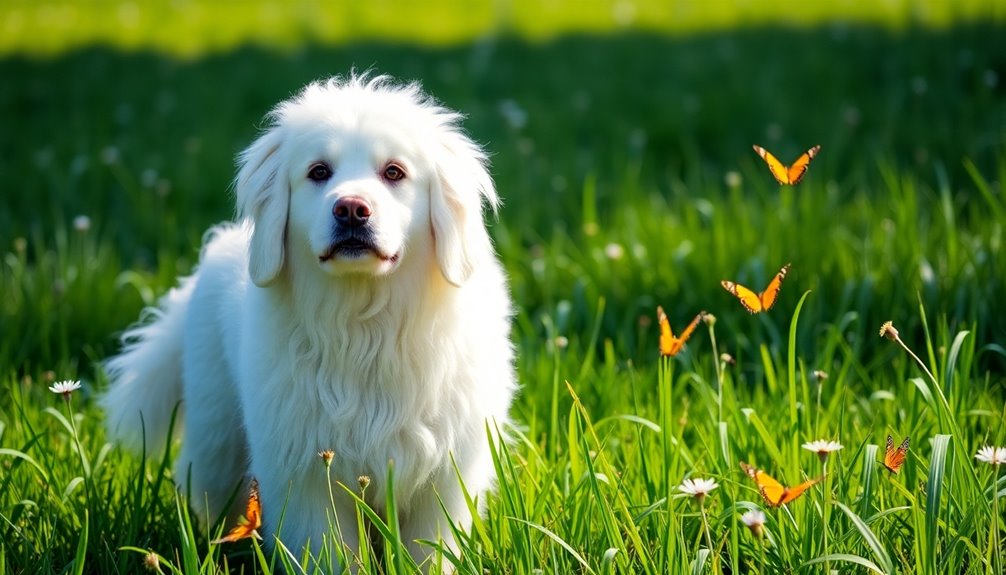
When you think about a Komondor, picture a dog that's both protective and watchful, always ready to defend its family. This breed can adapt well to families or individuals, bringing loyalty and affection into your home. Territorial behavior is an important aspect of their nature, as they establish boundaries to ensure the safety of their loved ones. If you have other pets, understanding their temperament is key to ensuring harmony in your household.
Protective and Watchful Demeanor
The Komondor's protective and watchful demeanor sets it apart as a formidable guardian. Wary of strangers, this breed is fiercely protective of its family, home, and possessions. Bred to guard livestock against predators, it instinctively knows how to act in defense, using its speed and power to drive away threats.
You'll find that its natural suspicion of the unfamiliar makes it an excellent watchdog, barking loudly at any potential danger, especially when near a fence. An independent thinker, the Komondor makes its own decisions to protect its territory. It can quickly sense intentions and will react accordingly—ignoring routine activity but alerting you to anything unusual. This breed thrives on responsibility, exhibiting calm vigilance while monitoring its surroundings. Handcrafted design for quality assurance ensures that the Komondor is not only a loyal protector but also a well-crafted companion.
You'll notice it taking a characteristic guarding position, ready to spring into action if needed. However, early socialization and obedience training are crucial. Starting training at 4-8 months helps the Komondor distinguish between friend and foe. Consistent, upbeat sessions will keep it engaged, ensuring it understands and follows your commands, while preventing unwanted behaviors from developing.
Suitability for families, individuals, or other pets
Komondors can be a wonderful addition to the right family or individual, thanks to their loyalty and affectionate nature. They form strong bonds with their primary caregivers and are protective of their loved ones. If you have dog-savvy children, especially older ones, a Komondor can thrive in your household, but supervision is essential due to their size and playfulness.
Keep in mind that they typically prefer a secure, fenced environment, preventing them from chasing other animals into traffic. Early socialization and consistent training are vital to help them distinguish between threats and non-threats. However, training can be challenging for inexperienced owners because of their independent nature. Additionally, regular exercise is crucial for their mental and physical health to ensure they remain happy and well-adjusted.
In terms of compatibility with other pets, Komondors generally do best in single-pet households. They may not get along well with other dogs and can be territorial. Introducing them to other pets requires careful management, although they might befriend cats if socialized early.
Ultimately, Komondors are best suited for experienced owners with an active lifestyle and ample living space, as they need regular exercise and daily grooming. If you can meet these needs, a Komondor can be a loving and loyal companion.
Health and Lifespan
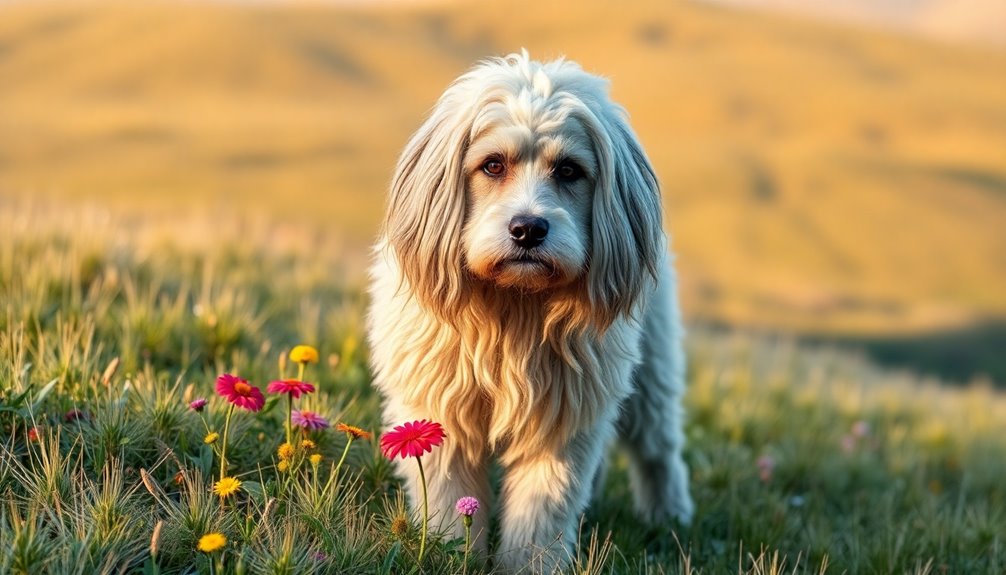
When it comes to your Komondor's health and lifespan, understanding their typical life expectancy of 10 to 12 years is essential. You should also be aware of common health concerns, like hip dysplasia and dental disease, that can impact their quality of life. Additionally, regular vet checkups are recommended for preventive care to help catch any potential issues early on.
Typical lifespan of the breed
For dog owners considering a Komondor, understanding the breed's lifespan is crucial. Typically, Komondors live between 10 and 12 years, which is standard for large breeds. However, with proper care, some can reach up to 14 years. Factors like diet, healthcare, and living conditions significantly influence their longevity. A balanced, biologically appropriate diet can enhance their overall health, while regular veterinary check-ups help catch potential issues early. Additionally, a species-appropriate diet is essential for preventing obesity and promoting vitality in large breeds like the Komondor.
It's important to note that, as a large breed, Komondors can be more susceptible to age-related illnesses and certain cancers. This makes your role in providing a healthy lifestyle even more vital. While their lifespan aligns with other large breeds like the Boxer, it's shorter than that of smaller breeds, which often live 10 to 15 years.
The breed's historical context has also played a role in their lifespan. Events like World War II negatively impacted their population, indirectly affecting genetics and health.
Despite these challenges, restoration efforts have stabilized their numbers. By maintaining a focus on their health and well-being, you can help your Komondor live a long, fulfilling life.
Common health concerns or genetic predispositions
While owning a Komondor can be a rewarding experience, being aware of common health concerns and genetic predispositions is essential for ensuring your dog's well-being.
One major health risk is hip dysplasia, which can lead to pain and reduced mobility. Bloat is another serious condition that can be fatal if not addressed immediately. Regular monitoring for ear infections and skin irritations like hot spots is crucial, as these are common issues for the breed. Additionally, due to their strong protective instincts, it's important to ensure they receive proper training and socialization to prevent behavioral issues.
Genetic conditions also pose risks. Intestinal Cobalamin Malabsorption (ICM) can cause severe gastrointestinal problems, including vomiting and diarrhea. Degenerative Myelopathy, an inherited disorder, typically presents around nine years of age and affects coordination, starting in the hind limbs.
Eye health shouldn't be overlooked; cataracts can impair vision, and entropion may require surgical correction to prevent further damage. Regular veterinary visits are vital for early detection of these issues.
Additionally, keep in mind that Komondors can be susceptible to gastrointestinal issues and infectious diseases. Understanding these health risks enables you to provide tailored care for your majestic mop dog.
Tips for maintaining health and wellness
Maintaining your Komondor's health and wellness is essential for a long, happy life, and there are several key areas to focus on.
First, prioritize high-quality nutrition. Choose premium kibble rich in proteins and vitamins, and consider supplementing with lean meats for added protein. Keep fats low and avoid feeding human food to prevent health issues. Remember that a well-nourished dog contributes to their overall health and lifespan.
Next, grooming is crucial, especially for their unique corded coat. Separate the cords every 9 to 10 months, bathe using dog shampoo, and ensure complete drying. Clean their ears weekly to ward off infections, and regular brushing helps distribute natural oils, keeping their coat healthy.
Exercise is vital too. Engage in daily walks, play sessions, and provide interactive toys to keep your Komondor physically and mentally stimulated. Balance exercise to avoid overexertion, especially when they're young, while ensuring they maintain agility despite their size.
Lastly, regular veterinary care is a must. Schedule check-ups, keep vaccinations up to date, and maintain a routine for dental care and nail trimming. Staying in touch with your vet helps catch any health issues early, ensuring your Komondor remains in top shape.
Care Requirements
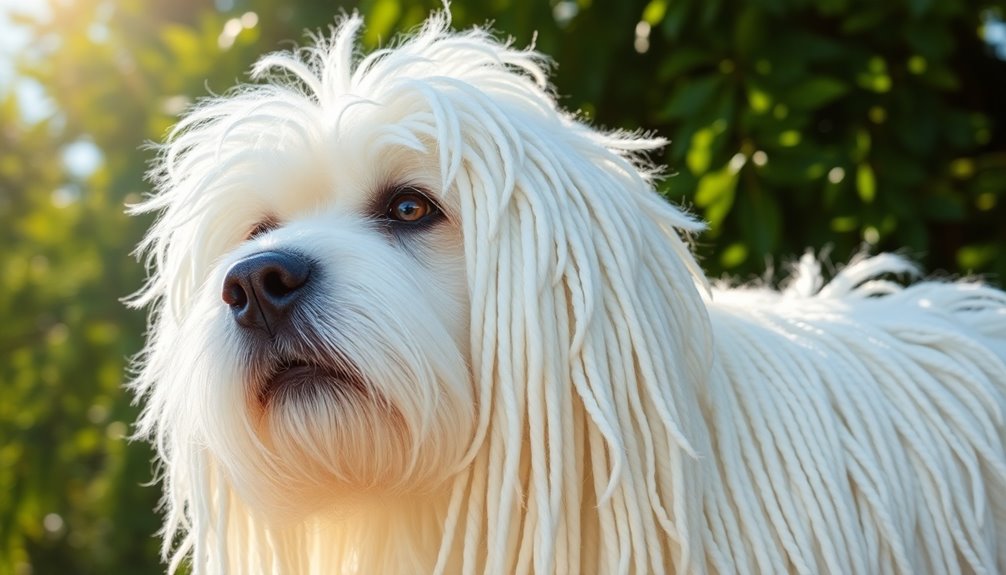
Caring for a Komondor involves regular cord maintenance, exercise, and a balanced diet. You'll need to separate their cords every few months and provide plenty of physical activity to keep their energy levels in check. Additionally, feeding them a nutritious diet will support their overall health and well-being. The breed's distinctive coat transforms from soft curls to heavy white cords as they mature, necessitating careful grooming practices.
Regular Cord Maintenance Required
To keep your Komondor's cords in optimal condition, regular maintenance is essential. Cords typically form by the time your dog is around two years old, and it's vital to separate them regularly to prevent matting and dirt buildup. Mist the cords with water or a light hydrating spray to help ease the separation process, and gently pull the strands apart, focusing on areas with greater density more often.
You should bathe your Komondor every 12 weeks or as needed. Before each bath, separate the cords to maintain their individual strands. Use a gentle squeezing motion to apply shampoo, avoiding circular scrubbing which can tangle the cords. Rinse thoroughly to ensure cleanliness, and be prepared for a lengthy drying process that can take 12-24 hours. Using fans or hair dryers can expedite this. It's also important to remember that cord health is maintained through regular inspection and care.
In addition, include regular grooming tasks, such as cleaning the ears every two weeks and trimming nails to prevent discomfort. Keeping a close eye on skin health, dental hygiene, and any signs of pests will ensure your Komondor remains happy and healthy.
Exercise requirements and energy levels
Regular grooming and maintenance keep your Komondor looking its best, but physical activity is just as important for their overall well-being. Daily walks are essential, and securely fenced yards provide a safe environment for exercise and exploration.
While they don't have excessively high exercise needs, your Komondor benefits from engaging activities that stimulate their natural instincts, like obedience training or agility exercises. Additionally, because of their large size, they may require more exercise than smaller breeds to maintain a healthy weight. Understanding energy levels can help you tailor their exercise routine effectively.
You'll notice that young Komondors have higher energy levels, requiring more physical and mental stimulation. As they age, their energy may decrease, but regular exercise remains crucial to avoid hyperactivity and weight gain.
Playtime with other dogs or activities like Frisbee can help burn off extra energy while keeping them socialized.
Swimming and light walks are excellent options for older or less active Komondors. Remember, a balanced exercise routine helps maintain muscle tone and prevents stiffness or painful joints.
It's important to consult with your veterinarian before starting any new exercise plan, especially if your dog has existing health conditions. Prioritizing their exercise needs will ensure a healthy and happy life for your majestic mop dog.
Feeding tips and diet recommendations
Feeding your Komondor is crucial for their overall health and vitality, so it's important to choose a high-quality diet that meets their nutritional needs. Ensure their meals include top-notch protein sources like chicken, fish, beef, or lamb, as protein is essential for muscle mass and overall health. A balanced diet should also incorporate both dry and wet food, providing the right mix of proteins, fats, and carbohydrates. Aim for essential fatty acids and natural vitamins from bone and plant sources, with small amounts of carbohydrates from vegetables and berries.
Control portion sizes to prevent obesity, and feed your adult Komondor twice a day to maintain energy levels. Puppies, on the other hand, require more frequent feedings—three or four times daily. It's important to note that high-quality protein sources significantly contribute to their muscle support and overall well-being.
Hydration is also key, so make sure they've access to fresh water or high-moisture foods. Avoid table scraps and animal bones to prevent stomach upset. Opt for AAFCO-approved food to ensure quality and nutritional standards. Lastly, consult your veterinarian before adding any supplements to their diet, as natural, whole food options are best. Following these guidelines will help keep your Komondor healthy and happy.
Training and Socialization
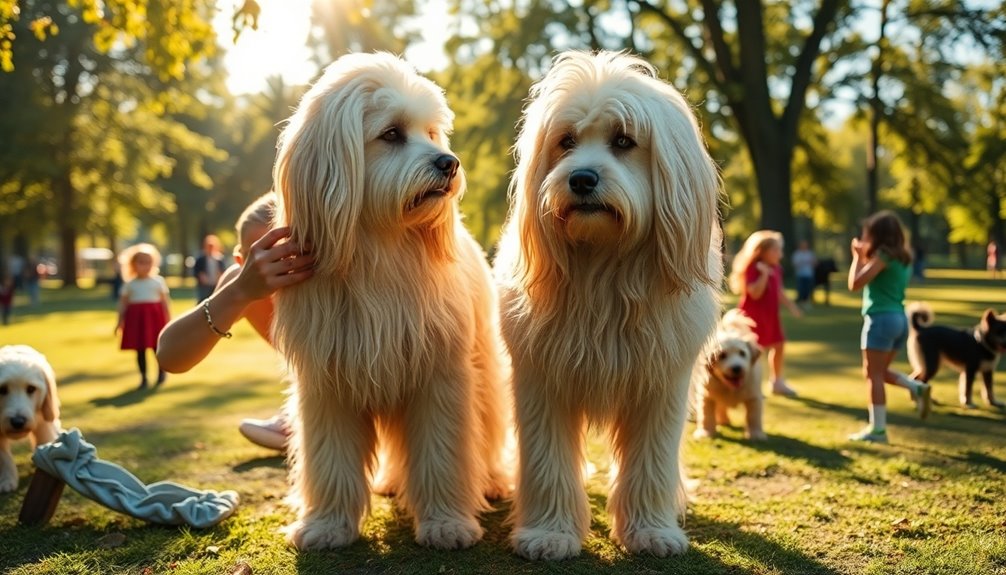
Training a Komondor can be challenging due to their stubbornness, so patience is key. Gradually introducing them to new environments helps reduce leash reactivity and builds their confidence. Given their distinctive white cords, it's important to ensure that their unique grooming needs are also addressed during training sessions.
Stubbornness Can Hinder Training
When you bring a Komondor into your home, you quickly realize that their intelligence can be a double-edged sword. While they're smart and capable, this same intelligence can lead to stubbornness, making training challenging. You might find that they easily get bored and may refuse to repeat learned behaviors, which can be frustrating. Their strong guarding instincts mean you need consistent control and training to channel that independence positively.
To combat stubbornness, start training early—ideally between 4 to 8 months. Early socialization is crucial to help your Komondor adapt to various situations and reduce aggressive tendencies. Additionally, be aware that early socialization can significantly influence their adaptability and stubbornness.
Keep training sessions short, varied, and fun, lasting about 10 minutes each to maintain their engagement. Use positive reinforcement like treats and verbal praise to encourage good behavior, but be wary of repetitive commands without association, as they can confuse your dog.
Inconsistent training practices can worsen stubborn behavior, so aim for consistency. If you're struggling, consider seeking help from a professional dog trainer. Understanding your Komondor's motivations will also set you up for a more effective training experience.
Gradual Introductions to New Environments
To ensure your Komondor thrives in various situations, gradual introductions to new environments are key. Start by letting your puppy explore different areas within your home. Once your pup feels comfortable, transition to quieter outdoor spaces like your backyard or familiar parks. As your Komondor gains confidence, increase the complexity of environments, moving to busier parks where joggers and cyclists abound.
It's essential to incorporate visits to pet-friendly stores and outdoor cafes. Use positive reinforcement—treats, praise, and affection—to create positive associations with these new experiences. Reward your pup for showing curiosity and confidence in unfamiliar settings, which helps desensitize them to everyday stimuli. Additionally, remember that early socialization is crucial for preventing anxiety and behavioral issues later on.
Don't forget to expose your Komondor to various sounds and sights. Introduce them to household noises like vacuum cleaners and doorbells, as well as outdoor sounds like traffic and birds. Meeting different people, including friends and neighbors, will also enhance their social skills. Always supervise interactions with other animals to prevent conflicts, ensuring each experience is positive.
Leash Reactivity in New Situations
Leash reactivity can often emerge during outings, especially in new situations where unfamiliar sights and sounds abound. This behavior, driven by fear, anxiety, or protective instincts, can lead your Komondor to lunge or bark at other dogs or people. Recognizing early signs, like a prolonged stare, is crucial for timely intervention.
To manage reactivity, start with basic leash skills, using positive reinforcement like treats and praise to encourage desired behavior. Reward your dog for making eye contact with you to foster focus.
When you encounter triggers, keep ample distance to prevent over-threshold reactions. Engage your dog with games or change direction using "switch backs" to redirect their attention. Understanding your dog's behavior can enhance your ability to respond to common causes of reactive behavior, leading to better training outcomes.
Desensitization and counterconditioning can be effective. Gradually expose your dog to triggers from a safe distance, rewarding them for calm behavior. Repeat this process to reinforce positive associations.
As your dog becomes more comfortable, gradually decrease the distance to the triggers.
If needed, consider consulting a veterinarian about medication options to support your training efforts. With patience and consistency, you can help your Komondor navigate new situations with confidence, minimizing leash reactivity.
Ideal Living Environment

If you're considering a Komondor, you'll need a spacious home with plenty of outdoor access. These dogs thrive in environments where they can roam freely, especially in colder weather. A large yard and regular outdoor activities are essential for their well-being and happiness. Additionally, their distinctive long, corded coat requires ample space to dry and maintain, making a well-ventilated outdoor area beneficial for their grooming needs.
Spacious Home With Outdoor Access
A spacious home with outdoor access is essential for a Komondor's well-being and happiness. This breed requires ample space to roam and expend energy, making a large property crucial. Urban settings often fall short due to their space constraints, so consider a fenced yard or a working farm environment where your Komondor can thrive.
It's vital to have extremely secure fencing to prevent your furry friend from escaping, as their curious nature often leads them to explore beyond boundaries. Daily outdoor exercise is non-negotiable; aim for at least two walks lasting about 30 minutes each. Access to large yards or designated exercise areas is beneficial, satisfying their curiosity and energy needs. Engaging in activities in a rural environment allows your Komondor to fulfill its instinctual needs.
A well-enriched outdoor environment will stimulate your Komondor, allowing them to engage in natural behaviors and social interactions.
The ideal living situation includes areas for resting, eating, drinking, and toilet needs, all separate from each other. By providing a spacious and secure environment, you'll ensure your Komondor leads a fulfilling life, filled with adventures and opportunities for exploration.
Cold Weather Adaptability
Komondors thrive in cold weather, making them well-suited for cooler climates. Bred to withstand harsh conditions, their thick, corded coats provide excellent insulation against low temperatures. The dense double coat helps retain body heat, allowing them to excel in snowy environments. You'll notice they seem happiest when the weather turns chilly, benefiting from their natural adaptations.
Their white, corded fur reflects heat and protects against wind, moisture, and extreme weather. This coat's consistency prevents snow and ice from sticking, reducing the cold's impact on their bodies. With a higher body fat percentage, they've an added layer of insulation to keep warm. Additionally, their guarding instincts make them vigilant protectors, even in challenging weather.
Even in winter, moderate daily exercise is essential. You can enjoy outdoor walks or playtime in your backyard, but monitor their comfort to avoid frostbite. Ensure they've access to shelter from extreme cold.
Adjusting their diet to provide extra calories during these months will support their energy needs. Lastly, consider protective measures like paw wax or booties to shield their feet from ice and salt. By following these guidelines, you'll help your Komondor thrive in their ideal cold-weather environment.
Distinctive Coat Requires Special Care
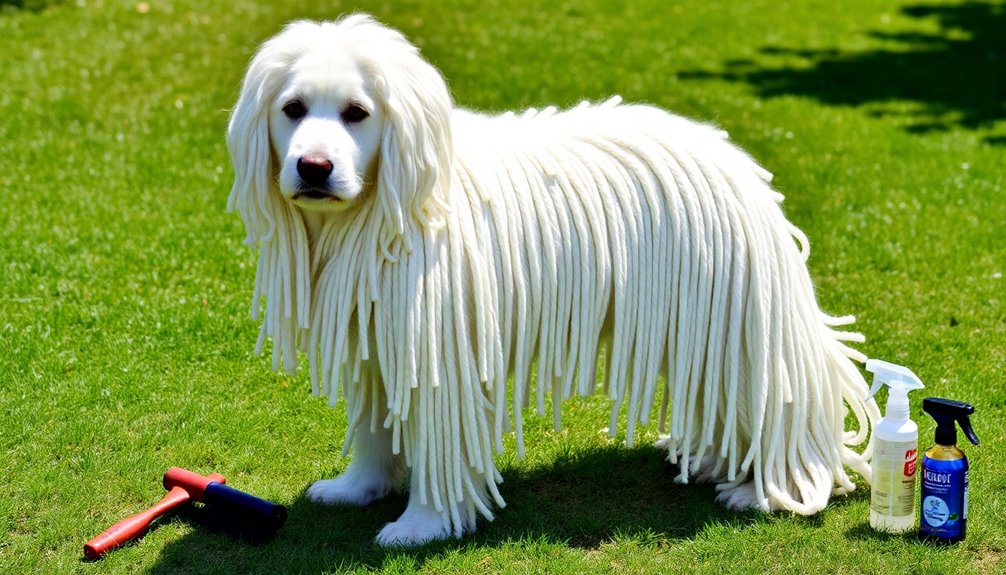
Taking care of a Komondor's distinctive coat is no small task, but it's essential for their well-being. This ancient breed, known for its protective instincts, has a unique look that even made an appearance in "The Secret Life of Pets." You'll need to commit to regular grooming to keep those impressive cords healthy and free from matting. Additionally, maintaining their coat is crucial for preventing skin conditions that can arise from neglect.
Ancient Breed Used for Protection
How did the Komondor evolve into such a revered protector of livestock? Originating in Hungary during the Migration Period, this ancient breed descended from herding and guardian dogs. With a lineage possibly including the Caucasian shepherd, the Komondor was primarily used to guard flocks of sheep and cattle from predators like coyotes and bears.
Its strong protective instincts have made it a valued companion for farmers and families alike. The Komondor doesn't herd; it stealthily watches over livestock, using its unique corded coat for camouflage. This coat, which requires special care, provides insulation and acts as natural armor. The self-cleaning fur of the Komondor minimizes maintenance, allowing it to stay functional even in challenging environments.
Its loyalty, intelligence, and fearlessness in the face of danger have cemented its reputation as a devoted protector. However, the breed faced near extinction during World War II, dwindling to just a few dozen individuals.
Today, the Komondor remains a symbol of strength and protection, cherished not just for its functionality but also for its steadfast companionship. If you're considering this majestic mop dog, be prepared for the commitment of grooming and care that its distinctive coat demands.
Famous in "The Secret Life of Pets
If you've seen the Komondor in "The Secret Life of Pets," you know its distinctive coat stands out, but maintaining that unique look isn't a walk in the park. The coat's soft, wooly undercoat and coarser outer coat work together to form long cords that resemble dreadlocks.
To keep these cords pristine, regular grooming is essential. You need to separate the cords frequently to prevent matting and dirt buildup. A mist of water or hydrating spray will help separate them before bathing.
When it's bath time, use diluted shampoo and avoid scrubbing in circular motions. Intensive rinsing is necessary to ensure all shampoo is removed, which can take some time. Additionally, be aware that their intelligent and independent nature may require you to be patient while grooming.
Drying the coat is a significant commitment, taking 12-24 hours, so using fans or a hair dryer on a cool setting can speed things up.
Be prepared for regular skin checks for ticks and fleas, and quick rinses are useful if your dog gets dirty.
Professional grooming might be necessary, especially if you find managing the cords overwhelming. With the right care, your Komondor won't only look stunning but also stay healthy!
Need for Extensive Grooming?
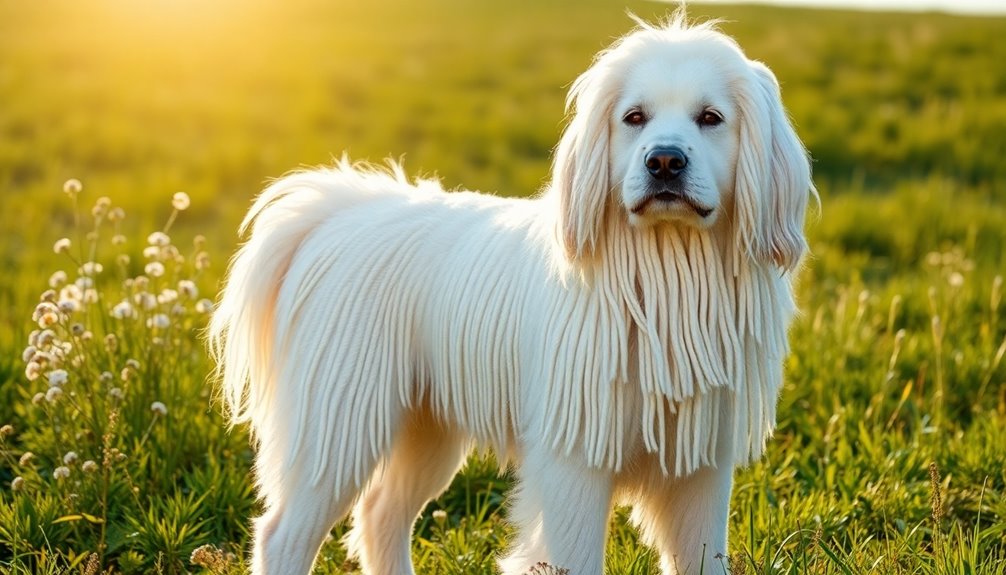
If you're considering a Komondor, be prepared for some serious grooming demands. This breed is ideal for experienced handlers who can commit to regular maintenance, including weekly cord separation and occasional baths. Maintaining their unique appearance with 15 pounds of dreadlocked fur requires diligence, but the rewards are well worth the effort.
Ideal for Experienced Handlers
For those considering a Komondor, it's crucial to understand that this breed is ideal for experienced handlers who can meet its extensive grooming needs and unique behavioral traits.
These dogs require owners who possess patience and a deep understanding of their instinctual role as livestock guardians. Successful Komondor owners know that they must allow their dogs to fulfill this duty, trusting them to make decisions about how to protect their territory. The breed's distinctive long, corded coat adds to their grooming needs and requires regular maintenance to ensure health.
Training and socialization are vital from an early age to manage their natural wariness of strangers. You'll need to provide engaging training sessions that keep your Komondor stimulated, as repetition can bore them. Use praise and humane corrections to foster a trusting relationship, but be prepared for their independent thinking.
Because Komondors are fiercely protective, they can be aggressive if they perceive a threat. Thus, it's essential to establish clear boundaries and provide regular exposure to different people and environments.
This breed thrives in rural settings where they can perform their guarding duties, making them unsuitable for city living. If you're ready to invest the time and effort, a Komondor can be a loyal and devoted companion.
Grooming Demands for Maintenance
Owning a Komondor comes with significant grooming responsibilities that can't be overlooked. You'll need to dedicate time daily to hand-groom their unique corded coat, carefully teasing out knots and tangles.
While cords can form naturally, you should separate them before bathing to keep them intact. Use your fingers to maintain the cords, and mist them with water or a light hydrating spray to ease separation. Pay special attention to friction-prone areas like the ears and under the tail.
When it's time for a bath, carefully shampoo each cord without using circular motions, and rinse thoroughly. Expect the coat to take 12-24 hours to dry completely, so make sure your Komondor stays warm during this time. Monthly baths are typically recommended, depending on your dog's activity level. Regular bathing helps to maintain hygiene and health by cleaning the skin and removing dirt, which is crucial for a breed like the Komondor.
Regular grooming tasks also include cleaning ears every four to six weeks, trimming nail and footpads, and maintaining dental hygiene. With consistent care, you'll help prevent skin irritation and infections.
Monitor their coat condition regularly to avoid tangles that could lead to health issues. Remember, the right tools can make a world of difference in ensuring your dog's comfort during grooming!
Frequently Asked Questions
Are Komondors Good With Children and Other Pets?
When considering if Komondors are good with children and other pets, you'll find they can be affectionate with older kids but require supervision due to their size and playful nature.
They mightn't be the best fit for households with young children.
As for other pets, they can be territorial and aggressive, especially towards unfamiliar animals.
Proper training and socialization are essential to ensure a harmonious environment, so preparation is key.
How Much Exercise Do Komondors Need Daily?
You'll want to give your dog about 30 minutes of daily exercise. This can easily be achieved through one or two walks each day.
While they're not high-energy, short and regular sessions keep them physically and mentally active. Outdoor play is great for their agility, and don't forget to incorporate interactive toys for mental stimulation.
Regular exercise helps prevent boredom, ensuring your dog stays happy and well-adjusted.
What Is the Average Weight of an Adult Komondor?
The average weight of an adult Komondor varies, with males typically weighing between 100 and 132 pounds, while females usually range from 70 to 110 pounds.
You'll notice that males are generally 20 to 30 pounds heavier than females, reflecting their larger size and muscle structure.
It's essential to manage their weight through proper diet and exercise to prevent health issues, so regular vet check-ups are important for maintaining a healthy weight.
Can Komondors Adapt to Apartment Living?
Komondors aren't ideal for apartment living due to their large size and territorial nature.
If you live in a condo or house, they can adapt, but you'll need to ensure they get plenty of exercise.
Providing a secure, spacious area for movement is essential, along with access to a fenced yard.
Daily walks and playtime will help keep them happy and healthy, allowing them to thrive in a larger living space.
How Do Komondors Handle Extreme Weather Conditions?
When it comes to extreme weather conditions, you'll find that dogs like the Komondor are well-equipped. Their thick, corded coat helps insulate them against cold temperatures, making them comfortable in winter.
However, in hot weather, you'll need to limit their outdoor time to prevent overheating, as the coat can trap heat. Providing plenty of shade and shelter is crucial to keep them cool during those scorching days.
Regular maintenance of their coat is essential for their health.
Conclusion
In conclusion, owning a Komondor can be a rewarding experience if you're ready for the commitment. Their unique appearance and loyal nature make them stand out, but they do require special care and attention. With proper training and grooming, you'll build a strong bond with your majestic mop dog. If you provide the right environment and care, your Komondor will thrive, bringing joy and companionship to your life for many years to come.


